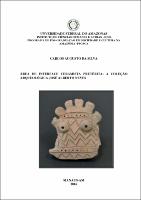| ???jsp.display-item.social.title??? |


|
Please use this identifier to cite or link to this item:
https://tede.ufam.edu.br/handle/tede/5219Full metadata record
| DC Field | Value | Language |
|---|---|---|
| dc.creator | Silva, Carlos Augusto da | - |
| dc.creator.Lattes | http://lattes.cnpq.br/7477532256270106 | por |
| dc.contributor.advisor1 | Neves, Eduardo Góes | - |
| dc.contributor.advisor1Lattes | http://lattes.cnpq.br/5240677783760196 | por |
| dc.contributor.advisor-co1 | Sampaio, Patrícia Maria Melo | - |
| dc.contributor.advisor-co1Lattes | http://lattes.cnpq.br/6775629541151867 | por |
| dc.date.issued | 2016-03-04 | - |
| dc.identifier.citation | SILVA, Carlos Augusto da. Área de interface ceramista pretérita: a coleção arqueológica José Alberto Neves. 2016. 211 f. Tese (Doutorado em Sociedade e Cultura na Amazônia) - Universidade Federal do Amazonas, Manaus, 2016. | por |
| dc.identifier.uri | http://tede.ufam.edu.br/handle/tede/5219 | - |
| dc.description.resumo | Este trabalho versa sobre a análise da Coleção Arqueológica José Alberto Neves, a qual é inédita, composta de cerca de vinte e cinco a trinta e cinco mil peças. A coleção está sediada na cidade de Urucurituba-AM; é particular, e o colecionador acondiciona as peças numa área de sua residência. O objetivo foi inventariá-la e disponibilizá-la em banco de dados digital e em publicação de catálogo de referência para que seja chancelada pelo órgão gestor do patrimônio arqueológico brasileiro. A Amazônia, pela sua área territorial e pelo fato de estar na maior floresta tropical do planeta, além de possuir a maior a bacia hidrográfica e os maiores rios navegáveis, possibilitou que as sociedades humanas pretéritas criassem alternativas para cultivar elevados números de produtos para a dieta alimentar. Ademais, as condições ambientais proporcionaram que nos dois últimos milênios houvesse enormes assentamentos humanos por toda parte da Amazônia. Dentre as várias alternativas para se adaptarem ao ambiente, quente e úmido, a indústria cerâmica foi talvez uma ferramenta útil para a sustentabilidade dos assentamentos. Para a análise da coleção, utilizou-se o método espiralado sistêmico, pelo fato de que as cerâmicas tinham determinadas funções dentro das sociedades que interagiam às margens dos rios da região. Da análise, chegou-se a inferir que as cores encravadas nas cerâmicas poderiam estar associadas às estampas nas tatuagens ou nas pinturas dos corpos dos indígenas. Trata-se de descrições que foram realizadas pelos naturalistas que estiveram na região, durante o século XIX. Outrossim, essas pinturas estão presentes na fauna da região. Por fim, a cerâmica era utilizada no cotidiano e para os eventos fúnebres, por longo período, na área do médio rio Amazonas e seus tributários. Com isso, as pesquisas arqueológicas e a literatura etnográfica vêm desvendando paulatinamente o modo de vida das sociedades indígenas pré-colombianas. | por |
| dc.description.abstract | This work deals with the analysis of the Archaeological Collection José Alberto Neves, which is unprecedented and composed of about twenty-five to thirty-five thousand pieces. The collection is headquartered in Urucurituba-AM; it is private, and the collector keeps the pieces in an area of his residence. The objective was to inventory it and make it available in a digital database and publication reference book to be approved by the governing body of the Brazilian archaeological heritage. The Amazon, for its territorial area and by being in the largest rainforest in the world and also for having the largest river basin and the major navigable rivers, enabled that the preterit human societies could be able to create alternatives to cultivate large numbers of products to the their feed. In addition, environmental conditions allowed that in the last two millennia there could be huge human settlements in the Amazon. Among the various alternatives to adapt to the environment, hot and humid, the ceramic industry was perhaps a useful tool for the sustainability of settlements. For the analysis of the collection, we used the systemic method of spiral, because the ceramic had certain functions within societies that interacted on the banks of rivers. From the analysis, we deduced that the colors of the ceramics could be associated with the tattoos or paintings on the bodies of the natives. They are descriptions that were made by naturalists who have been in the area during the nineteenth century. Moreover, those paintings are present in the fauna of the region. Finally, the ceramics was used in daily life and for the funeral events during a long period, in the area of the Middle Amazonas River and its tributaries. Therefore the archaeological researches and the ethnographic literatures have been discovering gradually the way of life of the indigenous pre-Columbian societies. | eng |
| dc.description.sponsorship | CAPES - Coordenação de Aperfeiçoamento de Pessoal de Nível Superior | por |
| dc.format | application/pdf | * |
| dc.thumbnail.url | http://tede.ufam.edu.br//retrieve/13811/Tese%20-%20Carlos%20Augusto%20da%20Silva.pdf.jpg | * |
| dc.language | por | por |
| dc.publisher | Universidade Federal do Amazonas | por |
| dc.publisher.department | Instituto de Ciências Humanas e Letras | por |
| dc.publisher.country | Brasil | por |
| dc.publisher.initials | UFAM | por |
| dc.publisher.program | Programa de Pós-graduação em Sociedade e Cultura na Amazônia | por |
| dc.rights | Acesso Aberto | por |
| dc.subject | Cerâmica arqueológica | por |
| dc.subject | Terra preta | por |
| dc.subject | Médio Rio Amazonas | por |
| dc.subject | Sociedade indígena | por |
| dc.subject.cnpq | CIÊNCIAS HUMANAS | por |
| dc.title | Área de interface ceramista pretérita: a coleção arqueológica José Alberto Neves | por |
| dc.type | Tese | por |
| Appears in Collections: | Mestrado em Sociedade e Cultura na Amazônia | |
Files in This Item:
| File | Description | Size | Format | |
|---|---|---|---|---|
| Tese - Carlos Augusto da Silva.pdf | Reprodução Total Autorizada | 24.7 MB | Adobe PDF |  Download/Open Preview |
Items in DSpace are protected by copyright, with all rights reserved, unless otherwise indicated.




